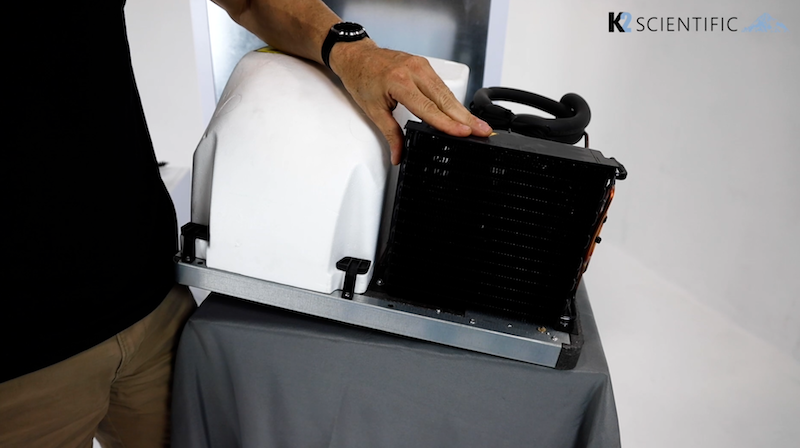Medical refrigerators are complicated machines, but their importance to your day-to-day operations can be overstated. Medical refrigerator failures can cause thousands of dollars in lost medical supplies and materials, making regular maintenance incredibly important. As complicated as these appliances may seem, the primary reason they fail is due to dirty condenser coils. Thankfully, you don’t need to be a medical refrigerator specialist to keep these devices in working order. Cleaning a condenser is simple and will extend the life of your medical refrigerator.
What is a Condenser?

A condenser is an essential component in the refrigeration process. Also known as the heat exchanger, this component is responsible for cooling down the hot refrigerant gas before it becomes the type of super-chilled liquid essential for modern refrigeration. As condensers often use air to cool the refrigerant, they’re one of few fan components that are easily accessible as the component often uses a fan to intake air.
The condenser is typically the second step in the refrigeration process, which involves four primary components:
- Compressor
- Condenser
- Expansion Valve
- Evaporator
This cyclical process begins when the liquid refrigerant flows into the compressor. The compressor does what the name suggests: compresses and pressurizes the liquid refrigerant until it heats up and turns into a gas or vapor.
Once the refrigerant has been pressurized and heated to around 140°F, it flows into the condenser. This condenser (also known as a heat exchanger), uses air or water to cool the hot gas refrigerant before it flows into the expansion valve.
The expansion valve gives the refrigerant space to rapidly expand. This process dramatically cools the refrigerant as it moves into the evaporator. Thermodynamics continues to take effect in the evaporator as the cold refrigerant pulls heat from the storage compartment, cooling the compartment’s air temperature. The refrigerant ultimately leaves the evaporator in its gas form and flows back into the compressor to start the cycle over again.
How Does a Condenser Get Dirty?
As long as the refrigerator is running, the condenser will constantly pull in air to cool the refrigerant. The condenser fan is typically covered with a grill that is just wide enough to allow air to pass through while still protecting the component from large objects that could damage it.
Over time, dirt and other material floating through the air will collect on the grate, reducing its effectiveness. Dirty condensers cause medical refrigerators to cool less efficiently or to not produce any cold air at all. Additionally, the harder the condenser has to work to pull in air, the more like it is that the refrigerator’s motor will burn out from the added stress from the dirty condenser.
How do I Clean a Medical Refrigerator Condenser
Before attempting to clean the condenser on your medical refrigerator, do the following:
- Remove the items from the refrigerator and place them into another refrigerator or storage device that will keep these items cold while you clean the condenser
- Locate the refrigerator power button and turn the device off
- Unplug the refrigerator to ensure it’s not receiving any power
From there, you will need to locate the condenser. The condenser is almost always located on the bottom of the appliance, although it will either be on the front or the back, depending on the design of your unit. Look for a removable grate on the bottom of the device; the condenser grill is likely located behind this cover.
To clean your condenser, do the following:
- Use a vacuum to remove dirt and dust. We recommend using a vacuum with a brush attachment so you can simultaneously brush the dust off the grill and remove it from the component. This will keep the dust and dirt from falling further into the condenser. Add condenser coil brush?
- Finish with a soft, damp cloth. Once you’ve removed the visible first and dust, you may also want to take a soft damp cloth and wipe down the external parts of the component to remove any excess dirt or dust.
- Complete the process. Replace the condenser cover, plug the device back into an outlet, and turn the refrigerator back on. Ensure the medical refrigerator is working and at the proper temperature before returning the items you removed prior to cleaning.
Ideally, you should be able to clean your condenser in just a few minutes.
How Often Should I Clean a Medical Refrigerator Condenser?
The cleaning frequency may depend on the quality of the air surrounding the condenser. Assuming your medical refrigerator is in an environment that is regularly cleaned and sanitized, you should only need to clean the condenser once a year.
Finally, you may also want to consider purchasing an air purifier for the room where you keep your medical refrigerator. These devices can remove excess dirt and dust from the air, thereby giving your medical refrigerator cleaner air to intake into the condenser and improving the lifetime of the appliance.
